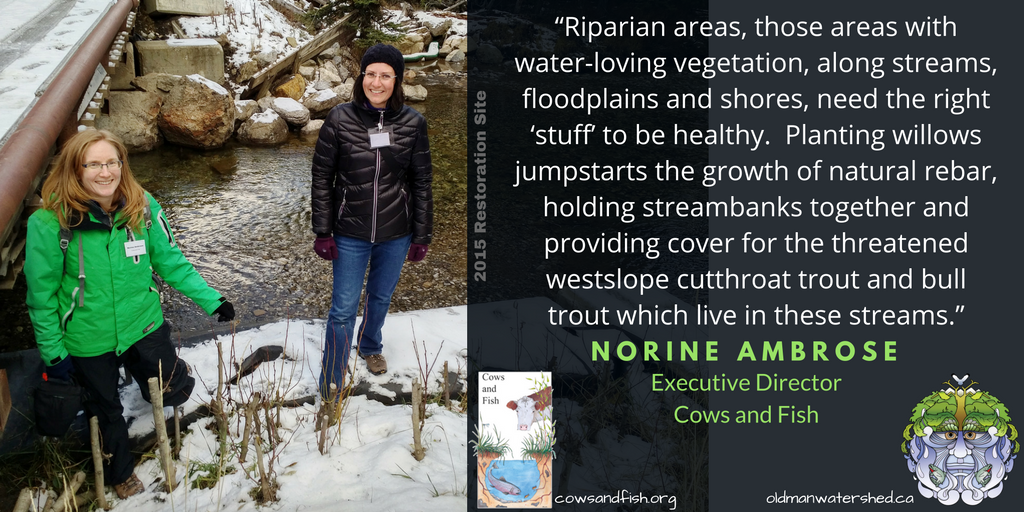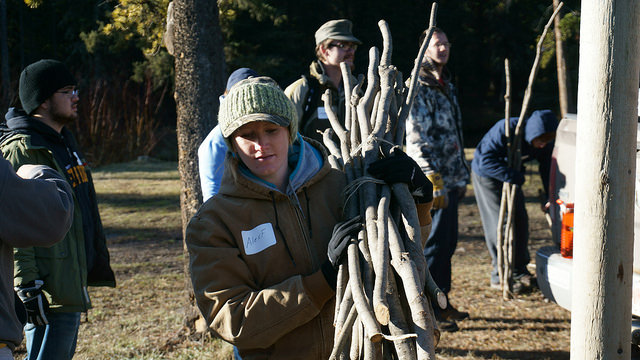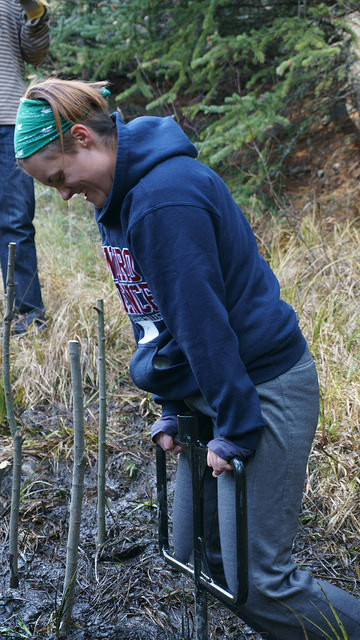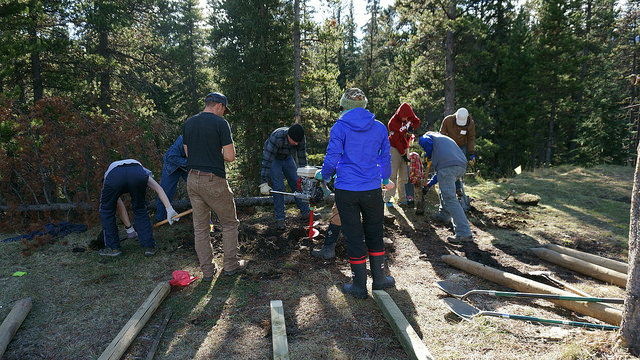by Francisco Samayoa, Outreach Assistant
Thank goodness it’s Friday! You’ve hitched up the trailer, packed your groceries, loaded your gear, and finally rounded up the kids. You set out to your favourite weekend destination, your own slice of paradise in the backcountry. After a long trek along bumpy roads (with the kids alternating between watching for wildlife and asking, “Are we there yet?”), at last you arrive… to find that the area next to your favourite camping and recreation spot, along the creek, has literally been “staked out.” The ground is covered with small stakes and possibly fence posts. Just what is going on?!?
You have arrived at a restoration site.
Caesar’s Flats following some TLC by volunteers in 2016. This restoration project involved a hard day’s work of riparian fencing and willow staking. Please allow the area time to recover!
Along the edge of a healthy river or creek, there is a strip of water-loving plants (called the riparian area) with an important job to do. You can think of riparian areas as nature's water filters. They stabilize streambanks, reduce erosion, provide shade and keep water cool (which fish & other wildlife love!), filter runoff, and help slow water in case of flooding. However, these riparian areas can be damaged by excessive and repetitive traffic - whether by foot, hoof, or tires - and the impacts flow downstream from the headwaters. Without some form of intervention (in the form of restoration and allowing time for regrowth), these areas are unable to recover naturally.
Folks who really know and care about the backcountry see the importance in maintaining healthy riparian areas in our headwaters. For the past couple of years, we have worked with partners like Cows and Fish, the Crowsnest Pass Quad Squad, Spray Lake Sawmills, and volunteers to restore riparian areas in Dutch Creek. We live-stake willows, which grow quickly and stabilize the streambanks. We also put up fence posts to remind people to go around the areas, giving them a chance to grow without disturbance. Check out photos from previous restoration events in 2015 and 2016.
The process of live staking willows requires three steps: Harvesting, Staking, and Monitoring.
The first step is to harvest the willows from a nearby area, during fall or early spring when they are dormant. We choose willows because they are fast-growing, do well in wet areas, and are able to sprout buds and roots from branch cuttings.
The next step, at the restoration site, is to make holes by pounding rebar into the ground until it reaches the water table; this increases your chances of the willows successfully rooting. You then insert your willow stakes into the holes that you just created, and pound the stakes deep into the soil. It’s hard work, but very effective when done correctly!
"Planting" is perhaps too gentle of a word...
"Pounding" willow stakes is hard work, but worth the effort!
After the willows have been planted, Cows and Fish come back and monitor them during the year to see the success rate. Last year, Cows and Fish were happy to report that 94% of the willows staked at our 2015 restoration event had successfully rooted and were growing! We look forward to seeing the outcomes of our 2016 restoration efforts at Caesar’s Flats.
The next time you’re out and about in the backcountry and come across willow stakes, remember to leave them be and allow them time to regrow, as it took a lot of hard work from volunteers, OHV clubs, random camping families, and even Scouts to help plant the willow stakes!
Visit Cows and Fish for more information on riparian staking.
Willows planted along Dutch Creek in 2015 are showing new growth - it's very exciting!
If you would like to help restore the riparian areas of our headwaters please don't be shy; we need all the volunteers we can get!
Volunteers at the 2016 Backcountry Restoration Event. We hope to see you at the 2017 event!
But wait! What about those darn cows?? See how our Watershed Legacy Program has helped keep 6795 cows and 300 sheep from our waterbodies and riparian areas by installing 35 km of riparian fencing and 23 off-stream watering units!










